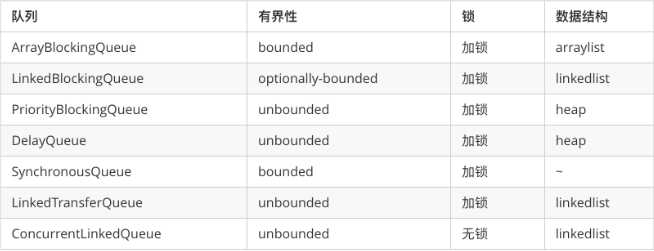阻塞队列(BlockingQueue)是 Java 5 并发新特性中的内容,阻塞队列的接口是 java.util.concurrent.BlockingQueue,它提供了两个附加操作:当队列中为空时,从队列中获取元素的操作将被阻塞;当队列满时,向队列中添加元素的操作将被阻塞。
阻塞队列常用于生产者和消费者的场景,生产者是往队列里添加元素的线程,消费者是从队列里拿元素的线程。阻塞队列就是生产者存放元素的容器。
阻塞队列提供了四种操作方法


下面分别简单介绍一下:
ArrayBlockingQueue:是一个用数组实现的有界阻塞队列,此队列按照先进先出(FIFO)的原则对元素进行排序。支持公平锁和非公平锁。【注:每一个线程在获取锁的时候可能都会排队等待,如果在等待时间上,先获取锁的线程的请求一定先被满足,那么这个锁就是公平的。反之,这个锁就是不公平的。公平的获取锁,也就是当前等待时间最长的线程先获取锁】
LinkedBlockingDeque: 一个由链表结构组成的双向阻塞队列。队列头部和尾部都可以添加和移除元素,多线程并发时,可以将锁的竞争最多降到一半。
这里分析下ArrayBlockingQueue的实现原理。构造方法:
ArrayBlockingQueue(int capacity); ArrayBlockingQueue(int capacity, boolean fair); ArrayBlockingQueue(int capacity, boolean fair, Collection<? extends E> c)
ArrayBlockingQueue提供了三种构造方法,参数含义如下:
插入元素:
public void put(E e) throws InterruptedException { checkNotNull(e); final ReentrantLock lock = this.lock; lock.lockInterruptibly(); try { while (count == items.length) notFull.await(); enqueue(e); } finally { lock.unlock(); } }
从源码可以看出,生产者首先获得锁lock,然后判断队列是否已经满了,如果满了,则等待,直到被唤醒,然后调用enqueue插入元素。
private void enqueue(E x) { // assert lock.getHoldCount() == 1; // assert items[putIndex] == null; final Object[] items = this.items; items[putIndex] = x; if (++putIndex == items.length) putIndex = 0; count++; notEmpty.signal(); }
以上是enqueue的实现,实现的操作是插入元素到一个环形数组,然后唤醒notEmpty上阻塞的线程。
public E take() throws InterruptedException { final ReentrantLock lock = this.lock; lock.lockInterruptibly(); try { while (count == 0) notEmpty.await(); return dequeue(); } finally { lock.unlock(); } }
从源码可以看出,消费者首先获得锁,然后判断队列是否为空,为空,则等待,直到被唤醒,然后调用dequeue获取元素。
private E dequeue() { // assert lock.getHoldCount() == 1; // assert items[takeIndex] != null; final Object[] items = this.items; @SuppressWarnings("unchecked") E x = (E) items[takeIndex]; items[takeIndex] = null; if (++takeIndex == items.length) takeIndex = 0; count--; if (itrs != null) itrs.elementDequeued(); notFull.signal(); return x; }
以上是dequeue的实现,获取环形数组当前takeIndex的元素,并及时将当前元素置为null,设置下一次takeIndex的值takeIndex++,然后唤醒notFull上阻塞的线程。
使用阻塞队列实现生产者-消费者模式
/** * Created by noly on 2017/5/19. */ public class BlockingQueueTest { public static void main (String[] args) { ArrayBlockingQueue<Integer> queue = new ArrayBlockingQueue<Integer>(10); Consumer consumer = new Consumer(queue); Producer producer = new Producer(queue); producer.start(); consumer.start(); } } class Consumer extends Thread { private ArrayBlockingQueue<Integer> queue; public Consumer(ArrayBlockingQueue<Integer> queue){ this.queue = queue; } @Override public void run() { while(true) { try { Integer i = queue.take(); System.out.println("消费者从队列取出元素:" + i); } catch (InterruptedException e) { e.printStackTrace(); } } } } class Producer extends Thread { private ArrayBlockingQueue<Integer> queue; public Producer(ArrayBlockingQueue<Integer> queue){ this.queue = queue; } @Override public void run() { for (int i = 0; i < 100; i++) { try { queue.put(i); System.out.println("生产者向队列插入元素:" + i); } catch (InterruptedException e) { e.printStackTrace(); } } } }
原文:https://www.cnblogs.com/deityjian/p/11087177.html